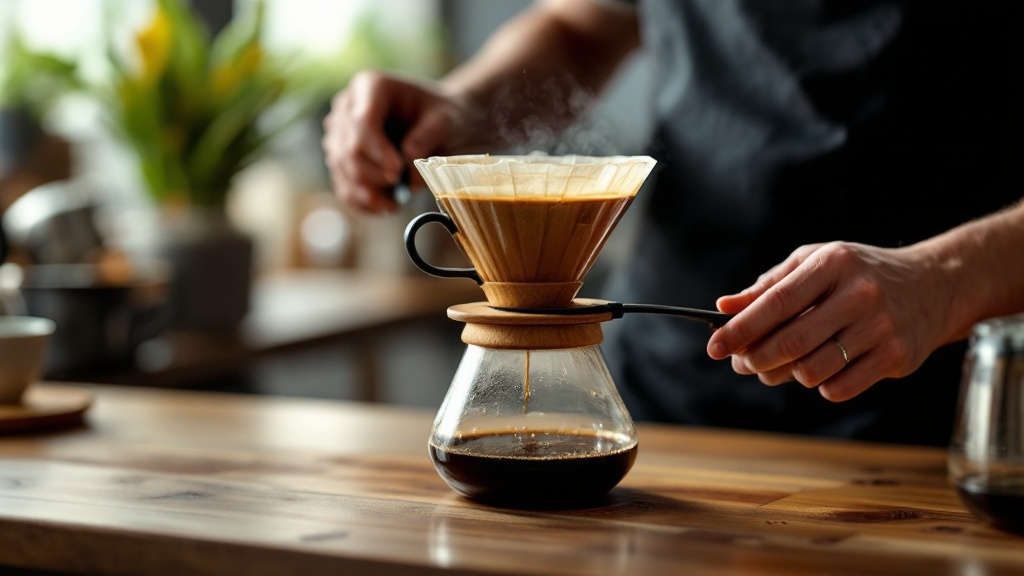Introduction: Unlock the Art of Pour Over Coffee
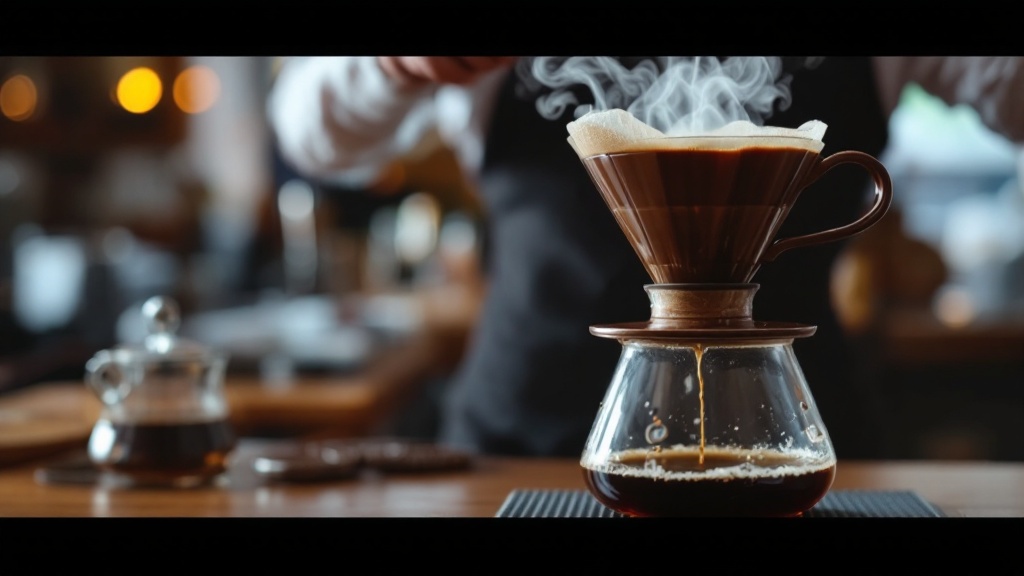
Forget the push-button convenience of automatic coffee makers. Are you ready to elevate your coffee experience? Pour-over coffee offers a captivating journey, a mindful ritual that transforms a simple morning beverage into a moment of exquisite taste and personal creation. It’s about taking control, dialing in your perfect cup, and appreciating the nuanced flavors hidden within each bean.
Forget the push-button convenience of automatic coffee makers. Are you ready to elevate your coffee experience? Pour-over coffee offers a captivating journey, a mindful ritual that transforms a simple morning beverage into a moment of exquisite taste and personal creation. It’s about taking control, dialing in your perfect cup, and appreciating the nuanced flavors hidden within each bean.
Pour-over brewing offers superior taste through meticulous control over every step, from grind size to water temperature. It’s a journey of customization, allowing you to tailor your brew to your exact preferences. And above all, it’s a deeply satisfying ritual, a meditative process that connects you to the craft of coffee making.
In this ultimate guide, you’ll learn everything you need to know to master the art of pour-over coffee, from choosing the right equipment to perfecting your pouring technique. We’ll even tackle troubleshooting those pesky brewing problems. Ready to discover the secret to the perfect cup? Let’s begin!
Ever wondered why your favorite café’s coffee tastes so much better? It might just be the pour-over method…
Forget the push-button convenience of automatic coffee makers. Are you ready to elevate your coffee experience? Pour-over coffee offers a captivating journey, a mindful ritual that transforms a simple morning beverage into a moment of exquisite taste and personal creation. It’s about taking control, dialing in your perfect cup, and appreciating the nuanced flavors hidden within each bean.
Pour-over brewing offers superior taste through meticulous control over every step, from grind size to water temperature. It’s a journey of customization, allowing you to tailor your brew to your exact preferences. And above all, it’s a deeply satisfying ritual, a meditative process that connects you to the craft of coffee making.
In this ultimate guide, you’ll learn everything you need to know to master the art of pour-over coffee, from choosing the right equipment to perfecting your pouring technique. We’ll even tackle troubleshooting those pesky brewing problems. Ready to discover the secret to the perfect cup? Let’s begin!
Ever wondered why your favorite café’s coffee tastes so much better? It might just be the pour-over method…
One key to unlocking the full potential of your pour-over coffee experience is selecting the right grinder. A burr grinder, as opposed to a blade grinder, will provide consistent grind size, crucial for even extraction and flavor. Remember, the optimal grind size for pour-over is typically medium to medium-fine, resembling sea salt in texture. However, this can vary based on your specific pour-over device and personal taste preferences.
Water temperature is another critical factor; too hot, and you risk over-extraction, leading to bitterness. Too cool, and under-extraction will make your coffee taste sour. The sweet spot is between 195°F to 205°F (90°C to 96°C), just off the boil. Using a gooseneck kettle not only gives you control over the water temperature but also over the pour itself, enabling a slow, steady stream that’s ideal for the bloom and subsequent pours.
Expert insight suggests that the bloom, a step where you pour just enough hot water to wet the grounds and let them sit for 30 to 45 seconds, is essential for degassing. This process allows carbon dioxide to escape, ensuring even saturation and extraction, which is key to unlocking the coffee’s full flavor profile.
However, common mistakes can detract from the perfect brew. One such error is pouring too quickly or unevenly, leading to channeling, where water bypasses some of the coffee grounds. This results in a brew that’s weak in some parts and over-extracted in others. Also, neglecting to clean your equipment thoroughly after each use can introduce unwanted bitterness or off-flavors into your coffee.
By paying close attention to these details and practicing your technique, you’ll soon be crafting pour-over coffee that rivals or even surpasses your favorite café’s. Remember, mastery comes with patience and experimentation, so embrace the process and enjoy the journey to pour-over perfection.
Mastering the Art of the Bloom: Timing and Technique
Section 1: Understanding Pour Over Coffee
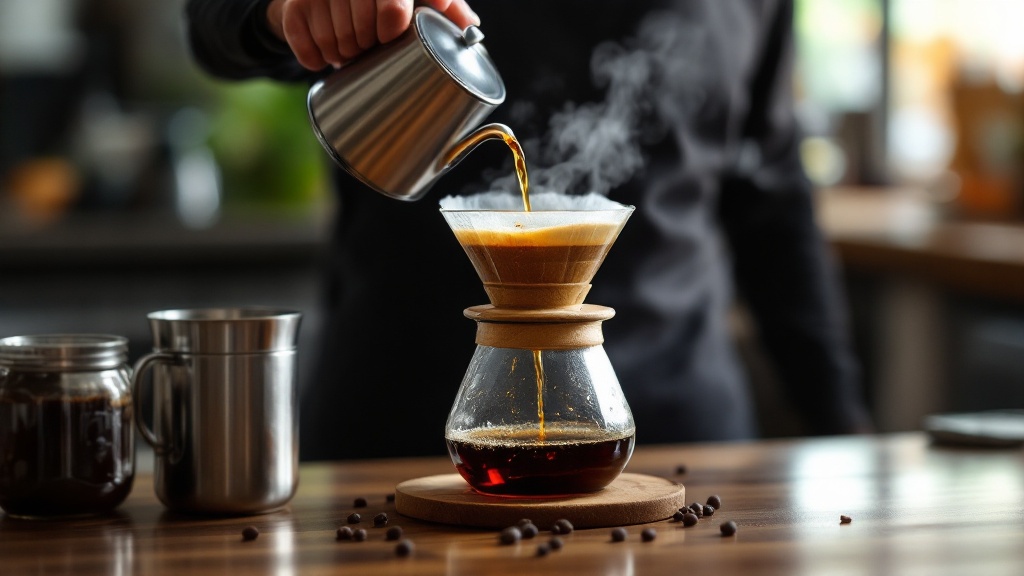
What is Pour Over Coffee?
Pour-over coffee is a manual brewing method where hot water is slowly poured over coffee grounds in a filter placed inside a dripper. This controlled flow allows for a precise extraction, resulting in a clean and nuanced cup. Unlike automatic drip machines which rely on gravity and immersion methods like French press which steep the grounds, pour-over offers unparalleled control over the brewing process.
Pour-over coffee is a manual brewing method where hot water is slowly poured over coffee grounds in a filter placed inside a dripper. This controlled flow allows for a precise extraction, resulting in a clean and nuanced cup. Unlike automatic drip machines which rely on gravity and immersion methods like French press which steep the grounds, pour-over offers unparalleled control over the brewing process.
The basic principles involve carefully controlling the water flow rate and temperature to optimize the extraction of flavors from the coffee grounds. This meticulous process is what separates pour-over from other methods, resulting in a highly customizable and flavorful cup. The history of pour-over is rich, with early iterations evolving from the Melitta filter in the early 20th century to the now-iconic Chemex and Hario V60.
Pour Over: A Manual Brewing Method
- Requires specialized equipment like a dripper, filter, and gooseneck kettle for optimal control.
- Allows for experimentation with different grind sizes, water temperatures, and pour techniques to fine-tune the flavor profile.
- Produces a cleaner, brighter cup compared to immersion methods due to the lack of sediment.
- The blooming process, where grounds are initially saturated, is crucial for even extraction and optimal flavor development.
- Popular dripper types include the Chemex, Hario V60, and Kalita Wave, each offering unique brewing characteristics.
- With practice, pour over allows for highly consistent and repeatable results.
Why Choose Pour Over?
Pour-over brewing offers several distinct advantages:
Pour-over brewing offers several distinct advantages:
Precision and Control:
You’re in complete command of every aspect of the brewing process, allowing for fine-tuning to your exact preferences.
Enhanced Flavor Depth:
The precise extraction highlights the nuanced flavors of the coffee beans, creating a cleaner and more complex taste.
Sustainable Brewing:
Reusable metal filters are an eco-friendly alternative to paper filters, minimizing waste.
Potential drawbacks include the time investment required and a slight learning curve. However, the rewarding experience and superior taste far outweigh the initial effort. Don’t let the perceived complexity intimidate you; pour-over is easier to master than you might think!
Pour Over: Benefits & Ease
- Enhanced Flavor Extraction: Precise control allows for a more nuanced and complex cup.
- Customization Options: Experiment with different grind sizes, water temperatures, and coffee beans to personalize your brew.
- Improved Coffee-to-Water Ratio: Achieve a perfect balance for a consistently delicious cup.
- Minimal Equipment Needed: A simple pour-over device, filter, kettle, and grinder are all you require.
- Visually Appealing Process: The ritualistic nature of pour-over adds to the overall enjoyment.
Types of Pour Over Drippers
Several popular drippers are available, each with its own unique characteristics:
Several popular drippers are available, each with its own unique characteristics:
Chemex:
Known for its elegant design and clean, smooth brew.
Hario V60:
Features a spiral rib design promoting even extraction and a brighter, more acidic cup.
Kalita Wave:
Its flat bottom and three holes provide a consistently saturated bed of grounds, resulting in a well-balanced cup.
Melitta:
A classic and reliable choice, offering a straightforward brewing experience.
Beginners might find the Kalita Wave or Melitta easier to start with due to their more forgiving design. As your skills develop, explore the Hario V60 or Chemex for a more refined brew.
Understanding pour-over coffee goes beyond simply knowing the basic process; it involves diving into the nuances that can make or break your coffee experience. For instance, when selecting coffee beans for pour-over, opt for single-origin beans to truly appreciate the distinct flavor profiles that can be extracted through this method. Moreover, the grind size plays a pivotal role in your coffee’s taste. A medium to medium-fine grind is generally recommended, as it ensures a balanced extraction without over or under-extracting the coffee.
When it comes to the practical side of making pour-over coffee, one key tip is to always pre-wet your filter. This not only removes any papery taste but also helps in sticking the filter to the dripper, ensuring no grounds make their way into your final cup. Additionally, the temperature of the water is crucial; aim for 195°F to 205°F for optimal extraction. Water that’s too hot can result in a bitter taste, while water that’s too cool might under-extract, leading to a sour coffee.
Expert insights suggest the importance of the bloom process – pouring a small amount of hot water over the grounds to let them “bloom” for about 30 seconds before continuing with the rest of the pour. This step allows for the release of carbon dioxide and ensures a more even saturation and, consequently, a fuller extraction of flavors. Furthermore, maintaining a consistent and slow pour rate is essential. Rushing the pour can lead to uneven extraction, while too slow a pour might over-extract, making your coffee bitter.
Common mistakes to avoid include neglecting the quality of water used. Since coffee is over 98% water, the taste of your brew can be significantly affected by the water quality. Using filtered or bottled water can result in a noticeably better cup. Another mistake is using inconsistent grind sizes, which can lead to uneven extraction and a less desirable cup. Lastly, many beginners fail to experiment with different ratios of coffee to water, which can vary depending on personal taste preferences. A good starting point is a 1:16 ratio of coffee to water, but don’t be afraid to adjust according to taste.
By paying attention to these details and avoiding common pitfalls, you’ll be well on your way to mastering the art of pour-over coffee. Remember, like any skill, it takes practice and patience to perfect. So, take your time, experiment, and most importantly, enjoy the process!
Pour Over Dripper Guide
- Kalita Wave’s flat bottom allows for even saturation, making it beginner-friendly.
- The Hario V60’s ribbed design increases surface area for optimal extraction.
- Chemex’s thick glass and unique filter create a clean, smooth cup.
- Melitta drippers offer a classic design with reliable performance.
- Consider dripper size based on cup volume; larger drippers for larger brews.
- Different drippers impact brew time and coffee characteristics.
The Art of Mastering Extraction: Techniques for Optimal Flavor
Section 2: Essential Equipment and Setup
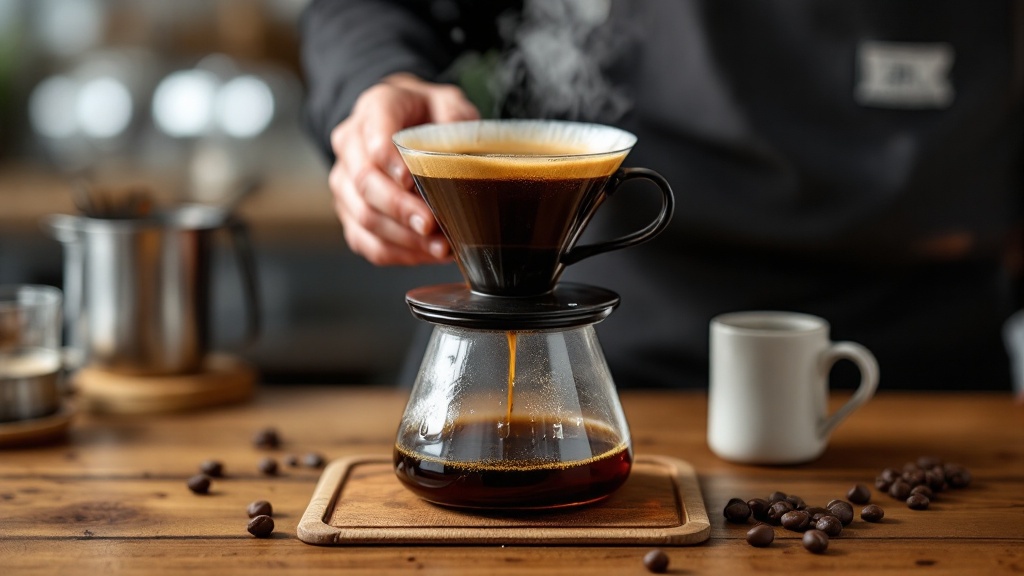
Choosing Your Grinder
A burr grinder is essential for consistent grind size, the cornerstone of a successful pour-over brew. Blade grinders produce uneven particles, leading to inconsistent extraction and uneven flavor. Consider your budget and desired features when selecting a grinder. Options range from budget-friendly hand grinders to high-end electric grinders.
A burr grinder is essential for consistent grind size, the cornerstone of a successful pour-over brew. Blade grinders produce uneven particles, leading to inconsistent extraction and uneven flavor. Consider your budget and desired features when selecting a grinder. Options range from budget-friendly hand grinders to high-end electric grinders.
Grinder Types & Considerations
- Hand grinders are portable and affordable, ideal for travel or low-volume brewing.
- Electric grinders offer speed and consistency, especially beneficial for larger batches.
- Burr grinders use two abrasive surfaces to produce consistent particle size, crucial for even extraction.
- Consider grind size adjustment: stepless adjustments offer more precision than stepped settings.
- High-end grinders often feature features like dose control and programmable timers.
Selecting Your Dripper and Filters
Choose a dripper based on your skill level and desired brew characteristics (as outlined above). Paper filters are readily available and contribute to a cleaner cup. Metal filters offer a more robust extraction, and are a more environmentally friendly choice.
Choose a dripper based on your skill level and desired brew characteristics (as outlined above). Paper filters are readily available and contribute to a cleaner cup. Metal filters offer a more robust extraction, and are a more environmentally friendly choice.
Dripper & Filter Selection Guide
- Pour-over drippers range from simple to complex designs; consider a Hario V60 for beginners or a Kalita Wave for more experienced users.
- Paper filters (e.g., bleached, unbleached, or brown) affect taste; experiment to find your preference.
- Metal filters (stainless steel, titanium, gold-plated) require more careful technique to avoid over-extraction.
- Reusable metal filters are more cost-effective in the long run and reduce waste.
- Filter size must match your chosen dripper for optimal performance.
Other Essential Tools
A gooseneck kettle is crucial for precise pouring and maintaining consistent water temperature. Look for one with good temperature control and a comfortable pour spout. A kitchen scale is indispensable for accurately measuring coffee and water ratios (precision scales offer the best accuracy). A timer and thermometer will also enhance your precision. Using a water filter will ensure you’re using clean water free of minerals which may negatively impact your brew.
A gooseneck kettle is crucial for precise pouring and maintaining consistent water temperature. Look for one with good temperature control and a comfortable pour spout. A kitchen scale is indispensable for accurately measuring coffee and water ratios (precision scales offer the best accuracy). A timer and thermometer will also enhance your precision. Using a water filter will ensure you’re using clean water free of minerals which may negatively impact your brew.
When diving into the world of pour-over coffee, the importance of a high-quality grinder cannot be overstated. A burr grinder, as opposed to a blade grinder, offers unparalleled consistency in grind size – a non-negotiable for the perfect pour-over. While blade grinders might be tempting due to their lower price point, they can significantly compromise the quality of your brew by producing uneven coffee grounds. This inconsistency leads to uneven extraction, where some coffee particles are over-extracted, resulting in bitterness, while others are under-extracted, offering a sour taste. For beginners, a hand burr grinder can be a great, budget-friendly option, providing good control over grind size. However, for those looking to invest in their coffee-making setup, an electric burr grinder with adjustable settings is ideal, allowing for precise control over the grind size tailored to your brewing method.
Selecting the right dripper is another critical step in your pour-over journey. The choice of dripper affects the flow rate and thus the contact time between the water and coffee grounds. For novices, the Hario V60 is a popular choice due to its forgiving nature and ease of use, while more experienced brewers might opt for a Chemex, known for its ability to produce a clean and complex cup of coffee. When it comes to filters, paper filters are the go-to for achieving a clean cup with minimal oils, offering a bright and clear flavor profile. However, for those seeking a fuller-bodied coffee with more oils and a richer taste, a metal filter can be the right choice. Remember, the choice of filter will also affect the cleanup process, with paper filters being disposable and metal filters requiring a bit more care to clean.
The role of a gooseneck kettle in the pour-over method cannot be overstated. Its design allows for a slow and steady flow of water, vital for an even extraction. When choosing a kettle, opting for one with a built-in thermometer can greatly aid in maintaining the optimal brewing temperature (195°F to 205°F). Additionally, investing in a digital kitchen scale with at least 0.1g accuracy is essential for achieving the perfect coffee-to-water ratio, which is crucial for consistency in your brew. A common mistake is to overlook the importance of water quality. Hard water can lead to scale buildup in your equipment and affect the taste of your coffee. Using filtered water can make a significant difference in the final cup.
Lastly, while enthusiasm and the right tools are crucial, patience and practice play a paramount role in mastering the pour-over coffee method. A common pitfall is rushing the pour, leading to under-extraction. It’s essential to take your time, especially during the blooming phase, to ensure your coffee grounds are evenly saturated. This preparation allows for a uniform extraction, resulting in a balanced and flavorful cup. Remember, mastering pour-over coffee is a journey, and every cup is a step towards perfection.
Essential Pour-Over Coffee Equipment
- Consider a kettle with a gooseneck and temperature gauge for precise pouring and temperature control, ideally between 195°F and 205°F.
- Invest in a burr grinder (hand or electric) for consistent grind size, avoiding the uneven extraction that blade grinders cause.
- Choose a dripper based on experience level – Hario V60 for beginners, Chemex for advanced users – and select paper or metal filters based on desired flavor profile.
- Use a kitchen scale with 0.1g accuracy for precise coffee-to-water ratios; this is crucial for consistent brewing.
- Employ a timer for consistent brewing times, ensuring even extraction and avoiding under- or over-extraction.
- Always use a water filter to remove minerals that can negatively affect coffee taste and your equipment.
Understanding Grind Size for Optimal Extraction
Section 3: Mastering the Pour Over Technique
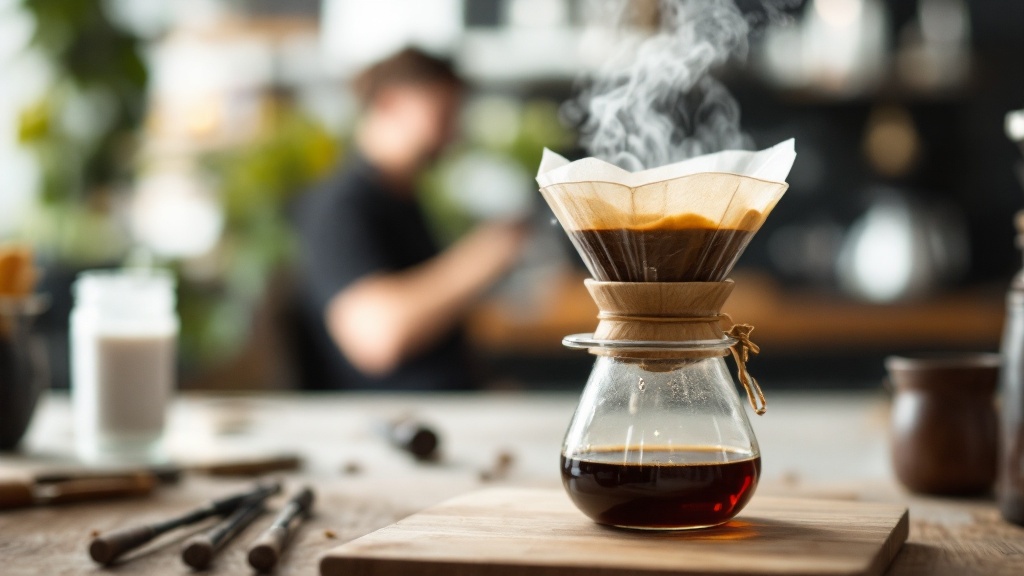
The Bloom
The bloom is a crucial initial step where you saturate the grounds with a small amount of hot water, releasing trapped carbon dioxide. This ensures even extraction and prevents channeling (water flowing through one area instead of the entire bed of grounds).
The bloom is a crucial initial step where you saturate the grounds with a small amount of hot water, releasing trapped carbon dioxide. This ensures even extraction and prevents channeling (water flowing through one area instead of the entire bed of grounds).
- Add grounds to the filter.
- Pour just enough water to saturate the grounds (about twice the weight of the grounds).
- Gently swirl to ensure all grounds are wet.
- Allow to bloom for 30-45 seconds.
Uneven blooming often indicates inconsistent grind size or uneven saturation. Insufficient bloom can lead to under-extraction.
Essential Coffee Bloom
- The ideal bloom time is typically 30-45 seconds.
- A good bloom will result in a gentle, even rise across the coffee bed.
- Using freshly roasted beans contributes to a more effective bloom.
- Water temperature should be between 195-205°F (90-96°C) for optimal CO2 release.
- Insufficient bloom often results in sour or under-extracted coffee.
- Over-blooming can lead to bitterness and over-extraction.
Pouring Techniques
Two main pouring techniques exist: pulse pouring and continuous pouring. Pulse pouring involves pouring small amounts of water, pausing to allow it to saturate the grounds before adding more. Continuous pouring involves a steady stream of water. Both methods can yield excellent results with practice. Choose the method that feels most comfortable.
Two main pouring techniques exist: pulse pouring and continuous pouring. Pulse pouring involves pouring small amounts of water, pausing to allow it to saturate the grounds before adding more. Continuous pouring involves a steady stream of water. Both methods can yield excellent results with practice. Choose the method that feels most comfortable.
Maintain a consistent circular motion to ensure even saturation and avoid pouring directly onto the filter.
Mastering Coffee Pouring
- Pulse pouring is ideal for less experienced brewers, allowing better control over saturation.
- Continuous pouring requires a steady hand and practice to achieve even extraction.
- The circular motion should be slow and deliberate, covering the entire coffee bed.
- Avoid pouring too forcefully, which can disrupt the coffee grounds and lead to uneven brewing.
- Experiment with different pouring heights to find what works best for your setup and coffee.
- Consider using a gooseneck kettle for precise control during both pouring methods.
Agitation Techniques (Optional)
Gently swirling or stirring the coffee grounds during the brewing process can improve extraction uniformity, but be cautious to avoid over-agitation. Over-agitation can lead to muddiness and bitterness.
Gently swirling or stirring the coffee grounds during the brewing process can improve extraction uniformity, but be cautious to avoid over-agitation. Over-agitation can lead to muddiness and bitterness.
The bloom process is the cornerstone of a refined pour-over technique, marking the beginning of a flavorful coffee journey. To perfect this initial step, it’s advisable to use hot water just off the boil, approximately 195°F to 205°F (90.5°C to 96.1°C). The precision in temperature aids in releasing the right amount of carbon dioxide without scalding the coffee grounds. A gooseneck kettle can offer superior control and accuracy in water flow, ensuring an even saturation. Remember, an inconsistent grind size can be the adversary of a successful bloom. A burr grinder is recommended over a blade grinder for a uniform grind size and, consequently, an even bloom.
When it comes to pouring techniques, the choice between pulse pouring and continuous pouring can influence the body and flavor of the coffee. Pulse pouring allows more control over the extraction time and can be particularly beneficial for lighter roasts, which may require a slower extraction to fully develop their complex flavors. On the other hand, continuous pouring is often preferred for its simplicity and consistency, ideal for those who appreciate a clean and balanced cup. For enthusiasts aiming to refine their pour-over method, experimenting with both techniques on the same coffee can reveal interesting nuances in flavor and body, offering a deeper understanding of how pouring affects extraction.
Agitation techniques, such as gently swirling the brewer or using a bamboo paddle to stir the grounds, can significantly impact the extraction process. The key is to agitate just enough to ensure all coffee grounds are equally exposed to water, promoting a more uniform extraction. However, it’s crucial to approach this step with a light touch; over-agitation can disrupt the coffee bed, leading to over-extraction in certain areas and under-extraction in others. This imbalance can manifest in the final cup as an uneven flavor profile, often with undesirable bitterness or sourness.
Common mistakes in pour-over brewing range from neglecting the quality of water used, which should be filtered and free of impurities, to overlooking the importance of a consistent grind size. Many enthusiasts also underestimate the effect of pouring speed and pattern on the extraction process. A slow, steady pour from a height of about 3-4 inches above the brewer encourages a gentle turbulence, enhancing flavor extraction without compacting the coffee bed, which can restrict water flow and lead to under-extraction. Conversely, a rapid or erratic pour can agitate the grounds excessively and create channels where water can bypass the coffee entirely, resulting in a weak, under-extracted brew.
By paying attention to these nuanced aspects of the pour-over method—from the bloom phase to the final pour—coffee aficionados can elevate their brewing technique, achieving a cup that is both delicately balanced and richly complex. Remember, mastering pour-over coffee is as much an art as it is a science, requiring patience, precision, and a willingness to experiment.
Pour-Over Agitation Techniques
- Use a gentle circular motion to avoid disturbing the coffee bed.
- A bamboo spoon or similar utensil can aid in even saturation.
- Over-agitation leads to uneven extraction, resulting in bitterness or sourness.
- Agitation is most beneficial during the bloom and initial pour stages.
- Experiment with different agitation levels to find what works best for your coffee and brewing method.
Understanding the Impact of Water Quality on Extraction
Section 4: Coffee Beans, Grind Size, and Water
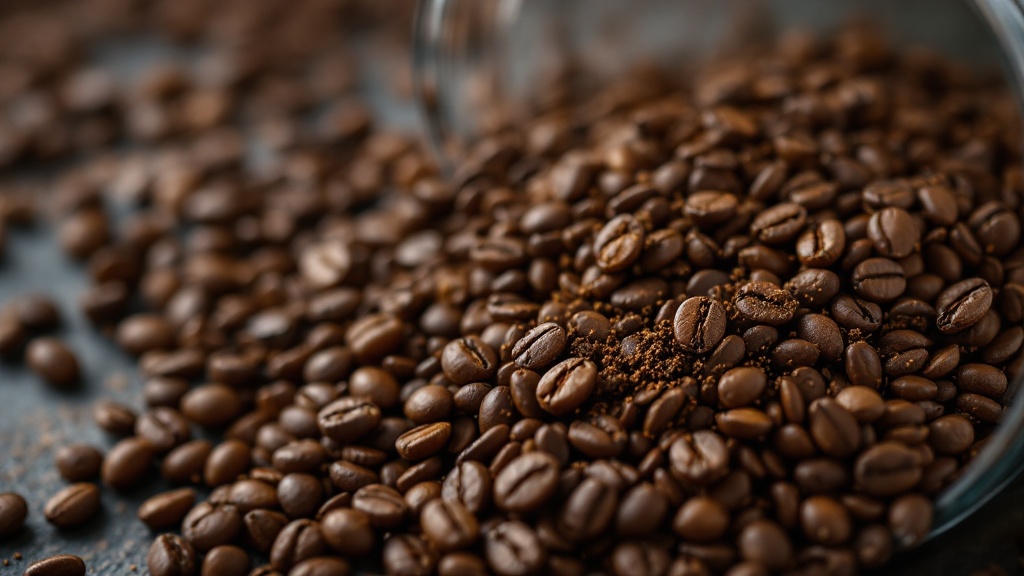
Selecting Coffee Beans
Use freshly roasted, high-quality beans for optimal flavor. Light to medium roasts generally work best for pour-over, as darker roasts can mask the delicate nuances of the coffee.
Use freshly roasted, high-quality beans for optimal flavor. Light to medium roasts generally work best for pour-over, as darker roasts can mask the delicate nuances of the coffee.
Choosing the Right Beans
- Consider bean origin: Ethiopian Yirgacheffe beans are known for their bright acidity, while Sumatran Mandheling offers a full-bodied, earthy flavor.
- Check the roast date: Aim for beans roasted within the last 2-3 weeks for peak freshness.
- Grind size matters: Use a burr grinder for consistent particle size, crucial for even extraction in pour-over brewing.
- Experiment with roast levels: While lighter roasts are often preferred for pour-over, taste preferences vary; try different roasts to find your favorite.
- Bean storage is key: Store beans in an airtight container in a cool, dark, and dry place to preserve freshness.
Achieving the Optimal Grind Size
Grind size directly impacts extraction. Too coarse a grind leads to under-extraction (sourness), while too fine a grind results in over-extraction (bitterness). Adjust your grind size based on your coffee and your desired brew.
Grind size directly impacts extraction. Too coarse a grind leads to under-extraction (sourness), while too fine a grind results in over-extraction (bitterness). Adjust your grind size based on your coffee and your desired brew.
Dialing in Your Grind
- Start with a medium-coarse grind for most brew methods, then adjust.
- A coarser grind is generally needed for pour over, while espresso requires a fine grind.
- Freshly roasted beans require a slightly coarser grind than older beans.
- Using a burr grinder is essential for consistent particle size.
- Adjust grind size in small increments (1-2 clicks at a time) for precise control.
- Taste your coffee after each adjustment to assess the extraction.
Water Quality and Temperature
Use filtered or spring water to avoid off-flavors from minerals. The ideal water temperature is between 195-205°F (90-96°C). Temperature significantly affects extraction; higher temperatures extract more, potentially leading to bitterness.
Use filtered or spring water to avoid off-flavors from minerals. The ideal water temperature is between 195-205°F (90-96°C). Temperature significantly affects extraction; higher temperatures extract more, potentially leading to bitterness.
Selecting the right coffee beans is paramount in achieving the quintessential cup of pour-over coffee. Opt for beans that have been roasted within the last two weeks to ensure freshness. While light to medium roasts are recommended for their ability to highlight subtle flavor notes, don’t shy away from experimenting with single-origin beans from regions like Ethiopia for floral and citrus notes or Colombia for a nuttier, chocolate profile. The key is to find a roast that complements your palate while being suitable for the pour-over method.
When it comes to grind size, think of it as the dial for fine-tuning your coffee’s flavor profile. A medium-coarse grind is generally a good starting point for pour-over. However, the exact grind size can vary depending on the pour-over device you’re using. For example, the Hario V60 demands a finer grind compared to the Chemex, which works better with a coarser grind due to its thicker filters. A practical tip is to invest in a quality burr grinder for consistent grind size. Experiment by adjusting your grind slightly finer or coarser with each brew until you hit the sweet spot where your coffee is neither under-extracted nor over-extracted.
Water quality can make or break your pour-over coffee. Tap water, especially in areas with high mineral content, can introduce off-flavors or interfere with the extraction process. Filtered or spring water is preferred for a cleaner taste. Moreover, the temperature of the water is crucial; too hot, and you risk over-extraction, too cool, and your coffee will be under-extracted. A digital kettle can help you hit that ideal 195-205°F (90-96°C) range with precision. Start your pour with a 30-45 second “bloom” pour, using just enough water to wet the grounds and allow them to expand. This helps release any carbon dioxide in the coffee, ensuring a more even extraction.
Common mistakes to avoid include overlooking the importance of the coffee-to-water ratio, which can drastically affect the strength and flavor of your brew. A general guideline is to start with a 1:16 coffee-to-water ratio and adjust based on your taste preference. Another mistake is neglecting cleanliness. Coffee oils and residues can build up in your equipment over time, introducing unwanted flavors into your brew. Regularly cleaning your grinder, pour-over cone, and kettle will help maintain the purity of your coffee.
Lastly, mastering pour-over coffee is as much about patience and practice as it is about precision. Take note of the variables you adjust with each brew, and how they affect the outcome. Over time, you’ll develop a deeper understanding and appreciation for the craft, leading you to your perfect cup of pour-over coffee.
Optimal Water for Pour-Over
- Avoid tap water with high chlorine or mineral content, as this can negatively impact flavor.
- Use a thermometer to ensure accurate water temperature for consistent extraction.
- Spring water offers a naturally balanced mineral profile suitable for enhancing coffee flavors.
- Consider using filtered water with a low total dissolved solids (TDS) content for a cleaner taste.
- Experiment with different water sources to discover which best complements your beans’ flavor profile.
Understanding the Impact of Coffee-to-Water Ratio on Flavor
Section 5: Recipes and Troubleshooting
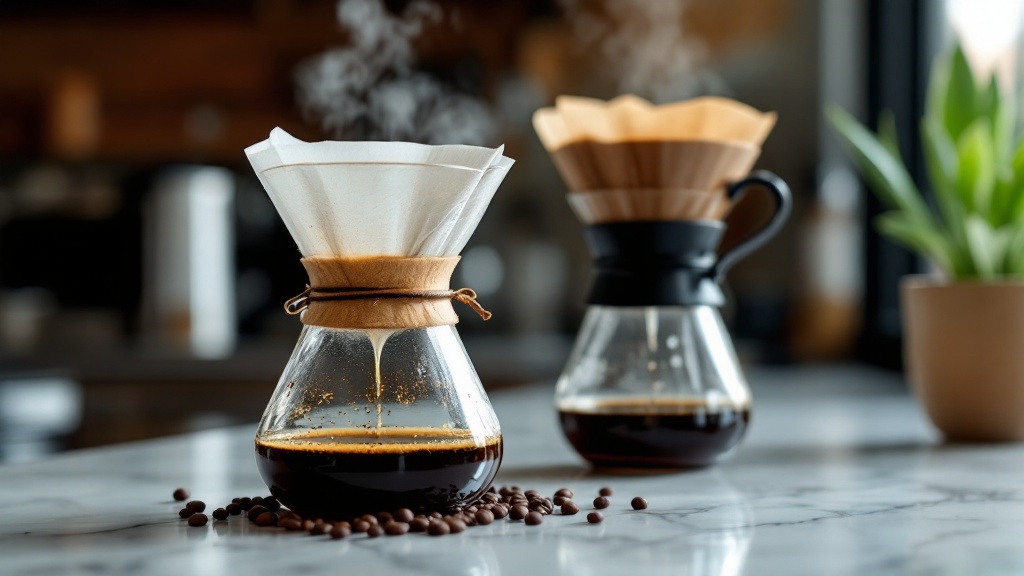
Sample Pour Over Recipe
Ratio:
1:16 (30g coffee to 500g water)
Ratio:
1:16 (30g coffee to 500g water)
Pour Over Coffee Basics
- Grind size: Use a medium-fine grind, similar to coarse sand.
- Water temperature: Heat filtered water to 200-205°F (93-96°C).
- Bloom the coffee: After adding grounds, pour just enough water to saturate them and let it sit for 30 seconds.
- Pouring technique: Use a slow, circular motion to evenly saturate the grounds.
- Total brew time: Aim for a total brew time of 3-4 minutes.
- Clean up: Rinse your pour-over device immediately after brewing to prevent coffee residue buildup.
- Heat water to 200°F (93°C).
- Grind 30g of coffee beans to a medium-fine consistency.
- Add grounds to the filter, and bloom with 60g of water for 30 seconds.
- Pour remaining water in a slow, circular motion, ensuring even saturation.
- Allow the coffee to drip through completely (approximately 3-4 minutes).
- Enjoy!
Troubleshooting Common Issues
Expanding on the basic recipe and troubleshooting tips provided, let’s dive deeper into the nuances of crafting the perfect pour-over coffee. The golden ratio of 1:16 (30g coffee to 500g water) is a fantastic starting point, but remember, the journey to your ideal cup might require slight adjustments. Personal taste preferences play a significant role, so feel free to experiment with the coffee-to-water ratio until you find your perfect match.
Sourness (Under-extraction):
Grind coarser, increase water temperature, or adjust pouring technique.
Bitterness (Over-extraction):
Grind finer, decrease water temperature, or shorten brewing time.
Uneven Extraction:
Ensure even saturation during pouring and check for channeling.
Expanding on the basic recipe and troubleshooting tips provided, let’s dive deeper into the nuances of crafting the perfect pour-over coffee. The golden ratio of 1:16 (30g coffee to 500g water) is a fantastic starting point, but remember, the journey to your ideal cup might require slight adjustments. Personal taste preferences play a significant role, so feel free to experiment with the coffee-to-water ratio until you find your perfect match.
When heating your water to 200°F (93°C), consider using a thermometer for precision. Water temperature is pivotal in the extraction process, influencing the flavors and aromas extracted from the coffee grounds. A variance of just a few degrees can dramatically alter the taste of your brew.
Grinding your coffee to a medium-fine consistency is crucial, but achieving uniformity in grind size is equally important. Inconsistent grinds can lead to uneven extraction, where some coffee particles are over-extracted (bitter) and others under-extracted (sour). Investing in a high-quality burr grinder can significantly improve your coffee’s taste by ensuring a consistent grind size.
During the bloom phase, ensure that all grounds are wet without disturbing them too much, as this can lead to uneven extraction. The bloom allows the coffee to degas, enabling a more even saturation and extraction during your pour.
As you pour the remaining water, use a gooseneck kettle for better control over the flow rate and direction. This precision helps avoid creating channels in the coffee bed, where water can pass through too quickly, resulting in under-extraction.
Expert Insights:
The quality of water used can significantly affect the taste of your pour-over coffee. Soft water or filtered water is often recommended over hard tap water, which can contain minerals that alter the flavor profile of your brew.
Common Mistakes to Avoid:
One of the most frequent mistakes in pour-over brewing is rushing the pour. A hasty pour can lead to inadequate saturation of the coffee grounds, affecting the overall balance and flavor of the coffee. Additionally, neglecting to clean your equipment properly after each use can result in the buildup of coffee oils and residues, which can impart unwanted flavors to your brew.
When troubleshooting, remember that adjustments should be made one at a time. If your coffee tastes too sour (indicative of under-extraction), try a slightly finer grind size first before adjusting water temperature or pour technique. Conversely, if your coffee is overly bitter (a sign of over-extraction), coarsen the grind slightly. Changing multiple variables at once can make it difficult to pinpoint the exact cause of the issue.
Lastly, keep a journal of your pour-over coffee experiments. Note the grind size, water temperature, ratio, and any adjustments made. Over time, you’ll develop a deeper understanding of how each variable influences your coffee’s taste, enabling you to consistently brew a cup that’s perfectly tailored to your preferences.
Pour-Over Troubleshooting Guide
- Use a calibrated thermometer for precise water temperature control (ideally 200°F/93°C).
- Employ a burr grinder for consistent particle size; uneven grinds cause sour or bitter brews.
- Avoid rushing the pour; a slow, even saturation ensures balanced extraction during brewing.
- Clean your equipment thoroughly after each use to prevent oil and residue buildup affecting flavor.
- Adjust one variable at a time (grind size, water temp, etc.) when troubleshooting.
- Keep a brewing journal to track variables and their effect on your coffee’s taste profile.
Mastering Grind Size for Optimal Extraction
Conclusion: Your Pour Over Journey Begins
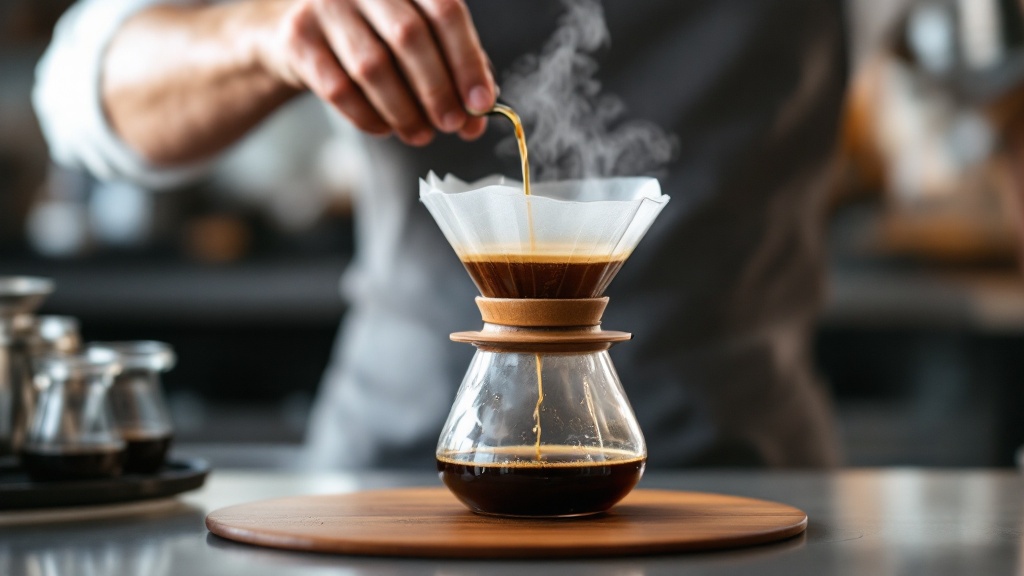
Mastering the pour-over technique takes time and practice, but the rewards are well worth the effort. Remember to experiment with different beans, grind sizes, and water temperatures to discover your perfect cup. Share your experiences and tips in the comments below!
Mastering the pour-over technique takes time and practice, but the rewards are well worth the effort. Remember to experiment with different beans, grind sizes, and water temperatures to discover your perfect cup. Share your experiences and tips in the comments below!
Start brewing today and unlock the rich, rewarding world of pour-over coffee!

